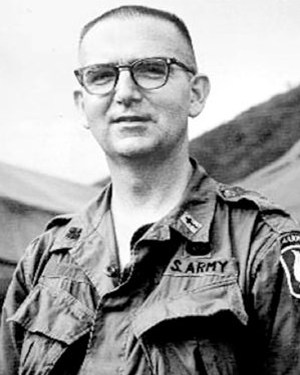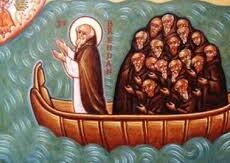
The Tet Offensive in January 1968 was a decisive event in the US involvement in the war in Vietnam. It didn’t happen overnight but involved an enemy buildup over several months in South Vietnam. It came to a head at a place called Dak To along the South Vietnam/Cambodian border.
Charles J. Watters was born in 1927 in Jersey City, New Jersey. He graduated from Seton Hall University and was ordained a Catholic Priest in 1953. He served in New Jersey parishes and was an active private pilot which led him to become a chaplain in the New Jersey National Guard. He volunteered for active duty in the US Army and started a tour of duty in Vietnam on 5 July 1966. He was assigned to the 173rd Airborne Brigade and was with the unit as it moved to the border in a search and destroy operation to locate the North Vietnamese.
A captured North Vietnamese soldier told intelligence officers that North Vietnam was assembling a large force in the vicinity of Dak To on the Cambodian border. A Special Forces team scouting the Dak To area collided with enemy troops on the slopes of Hill 875 and pulled back. The 173rd Airborne Brigade was ordered in to advance up Hill 875 and 570 troopers started up the hill on 19 November 1975. Father Watters was with the 173rd and was already a legend. On Sundays his saying was “Church call, No excuses.” On the way up he met Specialist Tom Brock saying “Tom, I think I’m getting too old for this.” “That makes two of us.” Brock replied. The North Vietnamese were dug in on both sides of the 173rd advance and opened fire causing heavy casualties. This was followed by an enemy assault that caused the 173rd to establish a perimeter followed by a request for air support. Father Watters repeatedly ran through intense fire to drag wounded soldiers into the perimeter. He was awarded the Medal of Honor for his valor.
Reinforcements were on the way, but that was taking too much time and increased air support was rushed to the scene. A burning tire on the slope was set up as a bomb release point for the attacking fighters, but as successive waves of fighter aircraft arrived the fire went out and another was started further down the slope. The arriving pilots were unaware of the change in the location of the fire and a single 500-pound bomb landed within the perimeter. Father Watters was killed and nearly 100 others were killed or wounded by the bomb. Reinforcements arrived and the enemy soldiers escaped through previously prepared tunnels. A little over 100 US soldiers were evacuated of the 570 that started up Hill 875. This was the costliest US attack of the war in Vietnam. General Westmoreland, the US commander told the New York Times that Dak To was the beginning of North Vietnam’s great defeat. In a sense he was correct. Tet ’68 was a tactical victory for the allies but it was also a great US political defeat. It turned US citizens against the war in Vietnam. It made it clear to the American public that overall victory in Vietnam was not imminent as they had been led to believe. Protests against the war intensified.


